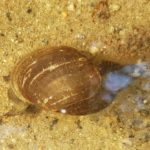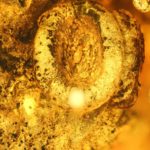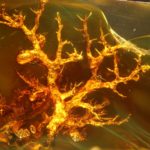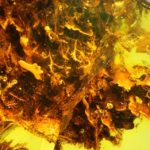Amber is fossilized tree resin, capable of preserving various organisms in cellular and ultrastructural fidelity. The vast majority of known lichen fossils are preserved in amber, mainly in Paleogene Baltic and Bitterfeld amber, but also in younger, Miocene Dominican and Ethiopian amber. In addition to the information about fungal and lichen evolution, these fossils also reveal us details about the past ecosystems and climate.
Recent posts
- Gastropods and mites enjoyed lichens also in the Paleogene
 In many modern ecosystems, lichens contribute significantly to primary production and nitrogen fixation, inhibit erosion, and efficiently capture and retain
In many modern ecosystems, lichens contribute significantly to primary production and nitrogen fixation, inhibit erosion, and efficiently capture and retain - Fourth amber deposit with fossil lichens: Miocene Ethiopian amber
 Amber deposits are predominantly known from North America, Europe, and Asia, and are considered to be rare on the continents
Amber deposits are predominantly known from North America, Europe, and Asia, and are considered to be rare on the continents - Extant genera of lichenized and lichenicolous fungi in Paleogene amber
 Representatives of the extant lichenized fungal genera Usnea and Ochrolechia and the lichen-inhabiting (lichenicolous) fungus Lichenostigma were already present in
Representatives of the extant lichenized fungal genera Usnea and Ochrolechia and the lichen-inhabiting (lichenicolous) fungus Lichenostigma were already present in - Diversity and ecological adaptations in Palaeogene lichens
 152 new fossil lichens have been discovered from European Palaeogene amber, increasing the total number of known fossil lichens from
152 new fossil lichens have been discovered from European Palaeogene amber, increasing the total number of known fossil lichens from - Epiphyte community in Dominican amber
 Epiphytes are, for example, vascular plants, bryophytes, or lichens, growing on other plants, like on tree trunks and branches. The
Epiphytes are, for example, vascular plants, bryophytes, or lichens, growing on other plants, like on tree trunks and branches. The - Variable analysis methods for fossil lichen inclusions in amber
 The use of variable analysis methods, including light microscopy, scanning electron microscopy (SEM), energy dispersive X-ray spectroscopy (EDX), and Raman
The use of variable analysis methods, including light microscopy, scanning electron microscopy (SEM), energy dispersive X-ray spectroscopy (EDX), and Raman